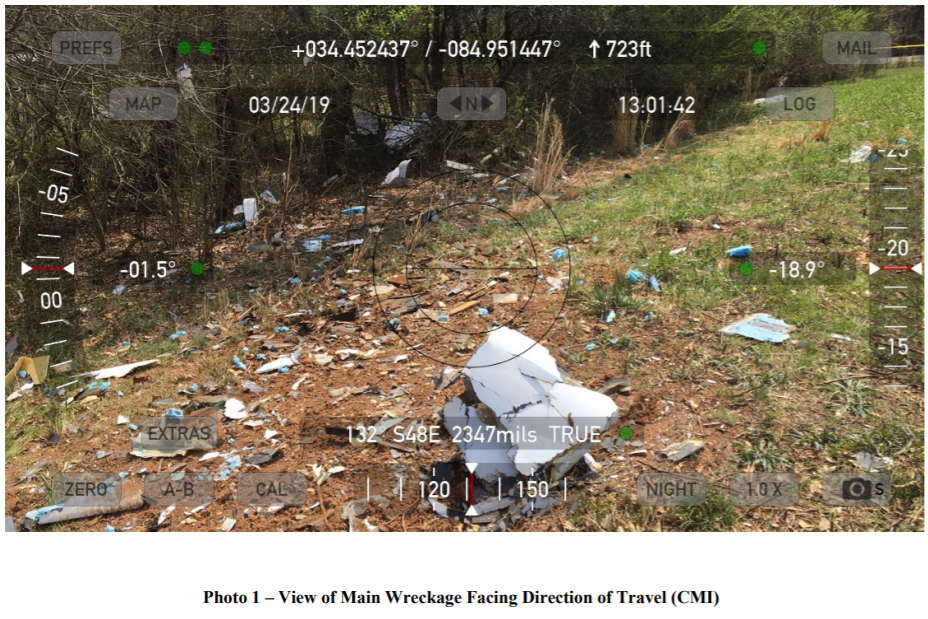
ASN Wikibase Occurrence # 223478
This information is added by users of ASN. Neither ASN nor the Flight Safety Foundation are responsible for the completeness or correctness of this information.
If you feel this information is incomplete or incorrect, you can submit corrected information.
| Date: | Saturday 23 March 2019 |
| Time: | 15:35 LT |
| Type: | Commuter Craft Innovator |
| Owner/operator: | Private |
| Registration: | N257AR |
| MSN: | 002 |
| Engine model: | Continental IOX-370-CLD1T |
| Fatalities: | Fatalities: 1 / Occupants: 1 |
| Aircraft damage: | Destroyed |
| Category: | Accident |
| Location: | near of Tom B David Field Airport (KCZL), Calhoun, GA -
 United States of America United States of America
|
| Phase: | Initial climb |
| Nature: | Test |
| Departure airport: | Calhoun-Tom B. David Field, GA (KCZL) |
| Calhoun-Tom B. David Field, GA (KCZL) | |
| Investigating agency: | NTSB |
| Confidence Rating: |
The pilot, who was also the owner/designer/builder of the experimental amateur-built airplane, had no recent flight experience and a medical certificate that had expired about 20 years before the accident flight. Despite assurances to his employees that he would not fly the airplane on what was its second test flight, video from inside the accident airplane showed that the pilot departed on the accident flight and the airplane immediately displayed rapid divergences in both the pitch and roll axis that were demonstrated on the airplane's first test flight. The airplane remained at treetop height throughout the upwind leg and into the crosswind turn and reached about 200 ft above ground level in level flight on the downwind leg. As the airplane accelerated, rapid pitch oscillations (phugoid) were exhibited. A handheld radio secured to the copilot's seat shoulder harness and the pilot himself were seen to "float" in the cockpit each time the airplane pitched nose down as the amplitude of the phugoid progressively increased, the duration of weightlessness displayed each time also increased. During one phugoid, an audible "oil pressure" warning was heard. The video ended abruptly as the pilot became unseated for about the fourth time and as the airplane appeared near treetop height. The airplane then impacted terrain.
The pilot had no experience in the accident airplane, which was the prototype for an airplane he intended to mass produce. A test pilot had completed the airplane's first flight in the traffic pattern. He described significant stability issues, which were captured by onboard video, and said the airplane departed controlled flight uncommanded about a dozen times. After the test pilot was able to safely land the airplane, it was disassembled, returned to the factory, modified according to the accident pilot's specifications based on captured data and the test pilot's observations, and then brought back to the departure airport for taxi testing the day before the accident.
According to employees of the company, the pilot was pressured by investors and missed deadlines, and was sleep-deprived and ill from a "severe" cold for which he was self-medicating. This pressure likely influenced the pilot's decision to test the prototype airplane himself despite his lack of experience and the stability issues demonstrated by the airplane on its initial test flight.
Examination of the wreckage and aircraft data captured from avionics systems, as well as statements from witnesses confirmed that the engine operated smoothly and continuously through the end of the flight. The condition of the wreckage precluded a thorough accounting of the flight control system; though based on statements provided by the previous test pilot, it is likely that the stability portrayed in the video of the first test flight remained during the accident flight, and when combined with the pilot's lack of experience, resulted in him being unable to maintain control of the airplane.
Probable Cause: The pilot's failure to maintain aircraft control during the airplane's second test flight, which resulted in a collision with terrain. Contributing to the accident was the pilot allowing external pressures to guide his decision to fly the airplane when he possessed little total flight experience, no recent flight experience, and no experience in the accident airplane or similar airplane.
Accident investigation:
 |
|
Sources:
FAA register: https://registry.faa.gov/aircraftinquiry/NNum_Results.aspx?NNumbertxt=N257AR
NTSB ERA19FA134
Location
Images:

Photo (c): NTSB

Photo: NTSB
Revision history:
| Date/time | Contributor | Updates |
|---|---|---|
| 23-Mar-2019 22:20 | Geno | Added |
| 24-Mar-2019 00:18 | RobertMB | Updated [Time, Source, Narrative] |
| 24-Mar-2019 02:53 | Geno | Updated [Source, Damage] |
| 24-Mar-2019 05:15 | RobertMB | Updated [Aircraft type, Registration, Cn, Operator, Nature, Source, Narrative] |
| 24-Mar-2019 16:51 | Geno | Updated [Phase, Nature, Departure airport, Destination airport, Source, Narrative] |
| 26-Aug-2020 08:40 | ASN Update Bot | Updated [Time, Departure airport, Destination airport, Source, Damage, Narrative] |
| 22-Mar-2021 20:23 | Captain Adam | Updated [Location, Source, Narrative, Photo] |
| 29-Mar-2021 17:37 | ASN Update Bot | Updated [Time, Other fatalities, Departure airport, Destination airport, Source, Narrative, Category, Accident report] |
| 29-Mar-2021 17:49 | harro | Updated [Location, Phase, Departure airport, Destination airport, Source, Damage, Narrative, Photo] |
Corrections or additions? ... Edit this accident description
The Aviation Safety Network is an exclusive service provided by:


 ©2024 Flight Safety Foundation
©2024 Flight Safety Foundation